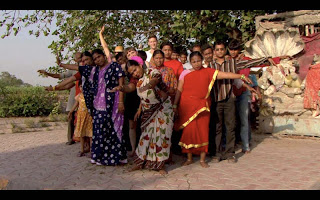We had to adjust to different ways of communicating during our collaboration with Patua artists. They spoke Bengali, while we spoke English, Polish, Lithuanian and Dutch. None of the languages known to us became useful in a direct contact with our colleagues. I started writing single Bengali words and short sentences down, to engage in the simplest conversations. They would learn the same words and sentences in English. However, what we really tried to understand was the language of symbols and signs - the information that came not only from what was said but also from the way it was said, the way people behaved, the way they lived…
Often in the evenings, we would sit down and de-construct what happened during the day, analyzing our mutual behaviours, trying to read from them. Then we built from it, re-creating the reality, learning.
In the film, this became mostly visible in three scenes, the dinner scene, the first dancing scene and the scene when I speak in Bengali.
To have a dinner with European food came up as an idea during one of our brain storming crits, where Transit\ion introduced the meaning of the term transformation, which was translated to Bengali as rupantor. To make sure that we all had a similar understanding of the word we had a brain storming session, where examples of transformation and possible ways of working with the term would be given. Suman suggested they experience some of our roles and environments, as Transit\ion had visited their villages and lived with them in theirs.
We responded to this with a dinner invitation, where the food cooked and served in a European manner was served and we acted as waiting staff, in the villages the Patua had always insisted on serving us.
The dancing scene was directed by the Patachitra. Tilly and I were invited/requested to participate. By following certain movements and realizing the symbolic significance embedded in them, with some help from Sumona (our translator and interpreter) we became aware of the meaning of the entire song. This awareness opened another door for us, becoming one more key to understanding Patuas and where their creative process begins.
The scene of me talking with Bablu was shot on one of the first days of making the film. I was asked to act in Bengali, but had no knowledge of what the text was about. I read from the tone of his voice and his body language and attempted to respond with the same type of emotion. I also wanted to stand up to him as a woman, I wanted my voice to be loud and my laugh to be powerful. What I was saying was secondary to the way I was saying it, letting my own experiences and believes influence the act.





















































